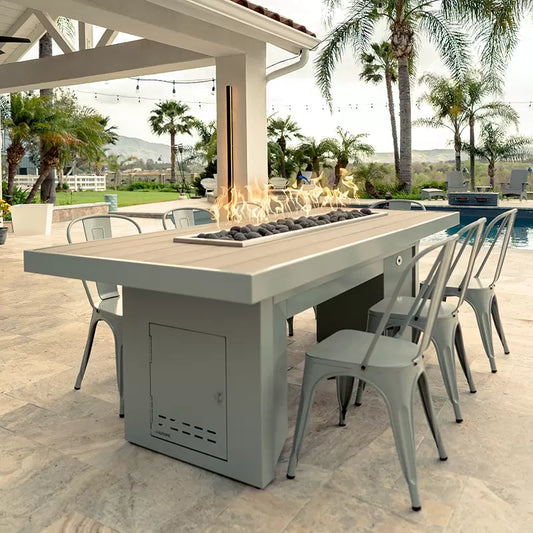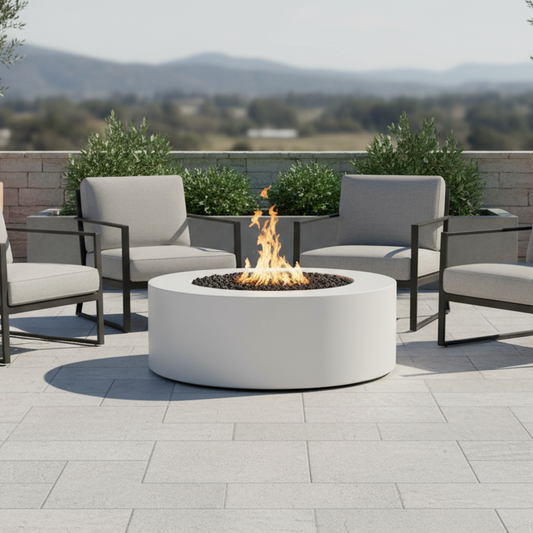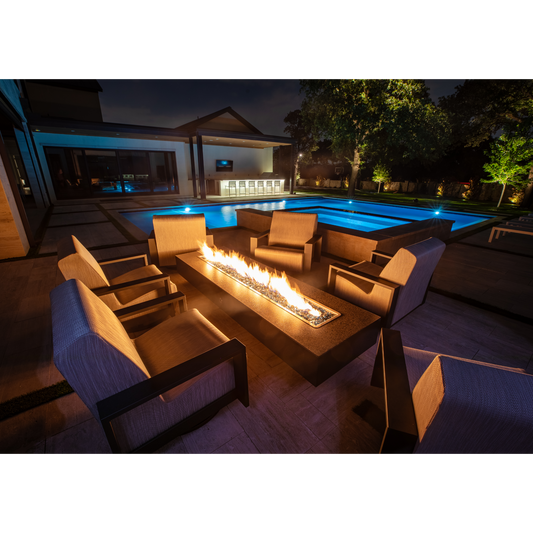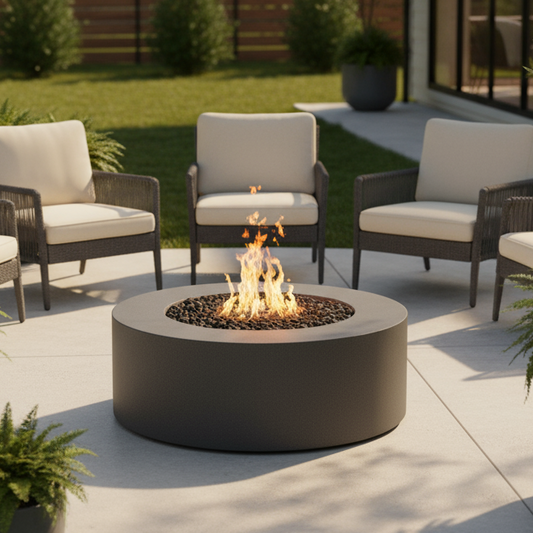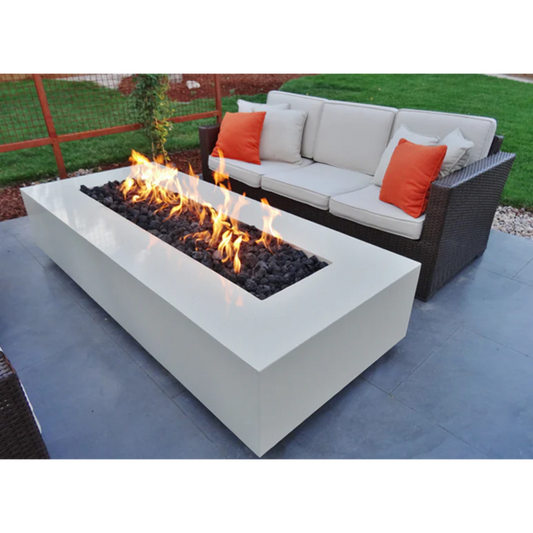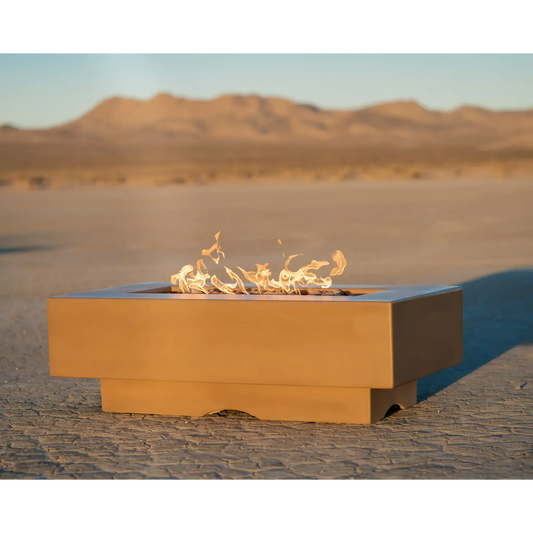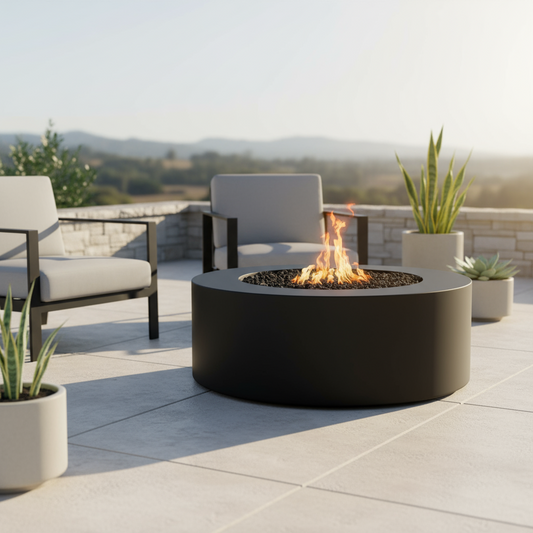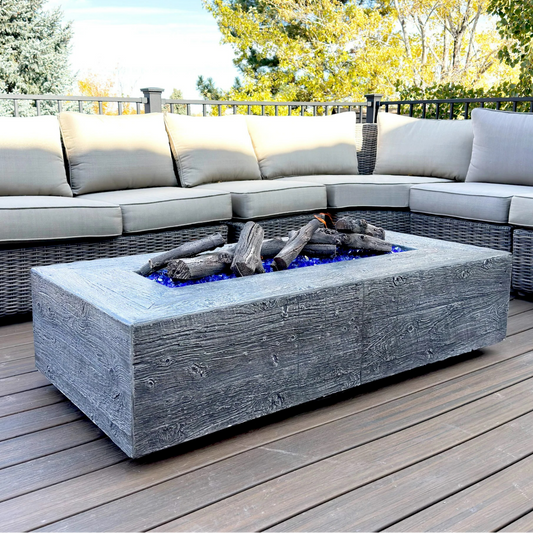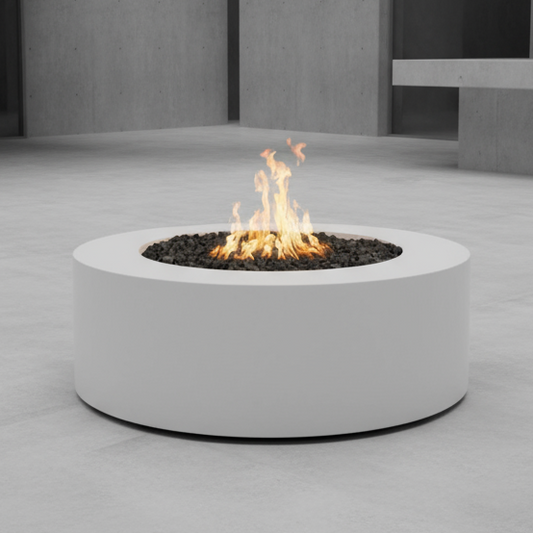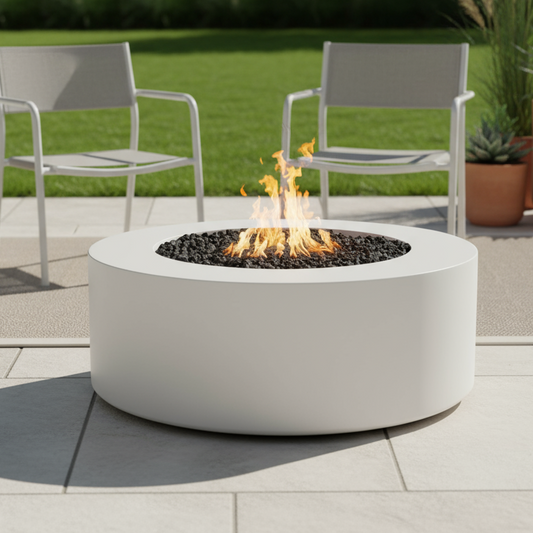How Far Should a Fire Pit (or Table) Be From the House?

Share
When people ask how far should a fire pit be from the house, they’re really asking, “Will my siding melt? Are my windows too close? Do soffits or a balcony above change the rules?” This spoke gives you:
- a starting range,
- a framework for increasing distance when conditions demand it, and
- a printable table + checklist you can take outside with a tape measure
We keep things simple in this blog by focusing only on distance from your house, walls, and nearby structures. For decks or pergolas, we link to a separate complete guide so you can dive deeper when needed: Fire Pit & Fire Pit Table Safety: Distances, Decks & Trees (U.S. Homeowner Guide).
Key Takeaways -
- Quick answer: Start at ≥3 ft (0.9 m) from walls/railings and ≥7–8 ft (2.1–2.4 m) of vertical clearance to eaves/soffits. Where space allows, aim for 5–7 ft (1.5–2.1 m) lateral and 10+ ft (3.0 m) vertical.
- What changes the distance: BTU output and flame height, appliance style (open bowl vs. lidded table), wind and orientation, siding material (vinyl vs. brick), nearby openings (windows/doors/vents), and corner/alcove layouts that trap heat.
- Rule to live by: Your owner’s manual and local residential fire pit regulations (permits, setbacks) always win. Use the most restrictive requirement.
-
Want the full safety ecosystem (decks, pergolas, trees, extinguishing)? See the pillar:
Fire Pit & Fire Pit Table Safety: Distances, Decks & Trees (U.S. Homeowner Guide).
Table of Content
- The Quick Answer: A Safe Starting Range
- What Changes the Distance?
- Distance Quick‑Reference (rule‑of‑thumb; use most restrictive manufacturer/local code)
- Horizontal vs. Vertical Clearances (and How to Measure)
- Common House Scenarios (Fast Guidance)
- Problem/Solution Mini‑Cases
- Pre‑Placement Safety Checklist (Printable)
- FAQs
- Conclusion & Next Steps
1. The Quick Answer: A Safe Starting Range
These are practical homeowner baselines for gas fire pits and gas fire pit tables. (Wood‑burning and smokeless fire pit products need greater distances because of sparks/embers.)

Authority first: Treat these as starting points. Your model’s manual and any gas fire pit code requirements in your city/county may specify larger setbacks—follow those every time.
2. What Changes the Distance?
Distances are not one‑size‑fits‑all. Use the adjusters below to move farther from the house when any apply.
Fuel & Output
Propane vs. natural gas: The propane fire pit distance from house is usually the same baseline as NG, but higher BTU output and taller flames radiate more heat.
Takeaway: Higher BTU or taller flames → increase both lateral and vertical clearances.
Have a look at our dedicated guide—Gas Fire Pit Tables: Natural Gas vs Propane (Costs & Installation)—that breaks down the differences between natural gas vs. propane fire pit tables, explaining installation, heat output, operating costs, and flexibility so you can choose the best option for your outdoor space.
Appliance Type
Open bowls radiate evenly in all directions. Lidded or furniture‑style fire pit tables and units with wind guards shape the plume but still require the same clearances unless the manual says otherwise.
Takeaway: Open bowl near sensitive siding? Favor the recommended distances.
Unit Size & Height
Larger burners (e.g., 36–48 in / 91–122 cm bowls) and tall flame beds push heat closer to eaves Takeaway: Bigger + taller → add distance, especially vertical.
Wind & Orientation
Prevailing winds bend flames toward walls. Corners and L‑shaped courtyards can funnel heat. Takeaway: Rotate the long burner axis into the breeze, add a wind guard, and increase clearance 1–2 ft (0.3–0.6 m) when winds are frequent.
Siding & Surfaces
Vinyl and painted wood deform more easily than brick, stone, or stucco. Reflective glass walls can bounce heat upward toward soffits.
Takeaway: Treat vinyl/wood as higher‑risk: aim for 7 ft (2.1 m) lateral when space allows; masonry can often live at 5–7 ft (1.5–2.1 m).
Openings & Features
Maintain distance from windows/doors, dryer vents, gas meter sets, and A/C equipment. Utilities often have their own setbacks to meters and intakes.
Takeaway: Keep ≥5 ft (1.5 m) from openings, and never block combustion or exhaust vents.
Accessories
Heat deflectors and wind guards can improve comfort and reduce nuisance—but they do not reduce required clearances unless the manual explicitly says so. Safety mats protect surfaces, not distances. Takeaway: Accessories control comfort; clearances remain the same.
Have a look at all available fire pit table accessories here: FIre Pit Table Accessories.
3. Distance Quick‑Reference (rule‑of‑thumb; use most restrictive manufacturer/local code)
|
Unit size (diam./length) |
Typical BTU range |
Vinyl/Wood lateral (min / preferred) |
Brick/Stone/Stucco lateral (min / preferred) |
Overhead clearance (min / preferred) |
|
Small ≤30″ (≤76 cm) |
≤65,000 |
3 ft / 5 ft (0.9 / 1.5 m) |
3 ft / 5 ft (0.9 / 1.5 m) |
7–8 ft / 10+ ft (2.1–2.4 / 3.0 m) |
|
Medium 32–36″ (81–91 cm) |
65,000–100,000 |
4 ft / 6–7 ft (1.2 / 1.8–2.1 m) |
3–4 ft / 5–6 ft (0.9–1.2 / 1.5–1.8 m) |
8 ft / 10+ ft (2.4 / 3.0 m) |
|
Large 38–42″ (97–107 cm) |
100,000–140,000 |
5 ft / 7 ft (1.5 / 2.1 m) |
4–5 ft / 6–7 ft (1.2–1.5 / 1.8–2.1 m) |
8–9 ft / 10+ ft (2.4–2.7 / 3.0 m) |
|
XL 44–54″ (112–137 cm) |
140,000–200,000+ |
6 ft / 8–10 ft (1.8 / 2.4–3.0 m) |
5–6 ft / 7–9 ft (1.5–1.8 / 2.1–2.7 m) |
9–10 ft / 11–12 ft (2.7–3.0 / 3.4–3.7 m) |
These numbers are conservative homeowner guidance for gas appliances. Wood‑burning units and “smokeless fire pit” designs should add extra distance.
4. Horizontal vs. Vertical Clearances (and How to Measure)
-
Horizontal = from the nearest flame area to the closest wall/railing/opening.
- Round bowl: measure from burner centerline to the wall.
- Rectangular fire pit table: measure from the nearest burner edge (not the table’s outside edge).
- Vertical = from the highest expected flame tip to the lowest overhead element (eave/soffit/beam).
Mini‑wrap: If vertical clearance is tight or you’re under an adjustable canopy, jump to Pergolas, Awnings & Covered Structures for options. For decks or balconies, see Deck Safety – Wood, Composite & Stone Decks.
5. Common House Scenarios (Fast Guidance)
Vinyl or Wood‑Sided Wall
- Start ≥7 ft (2.1 m); increase in wind or alcoves.
- Keep windows closed while burning.
- Tip: Add a wind guard and turn the unit so flames lean away from the wall.
Brick/Stone/Stucco Wall
- 5–7 ft (1.5–2.1 m) is common, but watch for reflected heat under soffits.
- Tip: If soffits warm quickly, move out or raise flame less.
Near Windows/Doors
- Keep ≥5 ft (1.5 m) horizontally; never burn under an openable window.
- Tip: Use another door while operating the fire.
Under Eaves/Soffits/Overhangs
- 7–8 ft (2.1–2.4 m) minimum; 10+ ft (3.0 m) preferred.
- Tip: If you can’t meet vertical clearance, relocate to open sky.
Corner/Alcove Placement
- Heat traps easily.
- Tip: Use the preferred distances from the table, not the minimums, and test with an IR thermometer.
Near Meters/HVAC/Vents
- Maintain space from gas meters, A/C units, and dryer/HRV vents; utilities and manufacturers list setbacks.
- Tip: When in doubt, call the utility and consult the appliance manual.
(Trees, fences, and pools?) See Trees, Fences & Pools: Safe Distances. (Deck questions?) → Deck Safety – Wood, Composite & Stone Decks.
6. Problem/Solution Mini‑Cases
Case 1 — Siding softens on a windy evening
- What happened: Wind pushed flame toward vinyl; the panel warmed and rippled.
- Fix: Move the unit 2 ft (0.6 m) farther out, add a wind guard, reduce flame height in gusts, and re‑orient the burner so the long axis faces the breeze.
Case 2 — Heat feels weak at a safe distance
- What happened: At 7 ft (2.1 m), guests don’t feel warmth.
- Fix: Move seating closer instead of the appliance; add a wind guard/deflector, verify gas pressure and regulator health, and ensure media isn’t smothering the burner.
7. Pre‑Placement Safety Checklist (Print this)
- □ Manual first: Note the model’s lateral and vertical clearances and any restrictions near openings.
- □ Local rules: Check residential fire pit regulations or HOA guidelines for setbacks and hours.
- □ Map hazards: windows/doors/vents, how far should a fire pit be from a fence, how far should fire pit be from trees, soffits/eaves, meters/HVAC.
- □ Measure & mark: From burner centerline, mark 3–7 ft (0.9–2.1 m) arcs; mark 7–10 ft (2.1–3.0 m) vertical space.
- □ Wind & orientation: Identify prevailing wind; rotate burner axis into the breeze; consider wind guard.
- □ Surface: Place on a non‑combustible base (concrete, pavers, stone). Asking “can i put fire pit on grass?”—not recommended near a house.
- □ Access & egress: Keep walk paths clear; verify shut‑off and extinguisher access.
- □ Final check: Pick the most open‑air spot with sky overhead.
Questions about a tricky layout? Contact a Specialist
8. FAQs
How far should a propane fire pit be from the house?
Use ≥3 ft (0.9 m) laterally and ≥7–8 ft (2.1–2.4 m) vertically; where possible, aim for 5–7 ft and 10+ ft. Confirm your manual and local rules.
What are typical gas fire pit code requirements near a dwelling?
Expect setbacks from walls and openings, and rules for overhead clearance. Some localities require permits. Always verify city/county guidance.
How far should a fire pit be from a fence?
Treat fences like walls: 5–10 ft (1.5–3.0 m) depending on material (vinyl needs more space). See [LINK: Trees, Fences & Pools: Safe Distances].
How far should fire pit be from trees?
Keep 10 ft (3.0 m) from branches/hedges; trim anything entering the heat envelope.
Can a gas fire pit be right next to a wall?
No—maintain clearance on all sides and overhead. Corners and alcoves need more room because heat pools.
Can I put fire pit on grass near the house?
It’s unsafe and unstable; use a non‑combustible base like stone or concrete and keep the same clearances.
Do smokeless fire pits change the required distance?
No. Despite reduced smoke, they’re wood‑burning and produce significant heat/embers—use greater setbacks than gas.
9. Conclusion & Next Steps
Start conservatively: 3 ft (0.9 m) lateral, 7–8 ft (2.1–2.4 m) vertical—then push outward for higher BTU, open bowls, vinyl siding, wind, and corners. Let the manual and local code make the final call, and keep windows/vents out of the heat plume.
- Browse safe, certified options: Fire Pit Table Collection
- Need tailored advice? Talk to a Safety Specialist
For decks, pergolas, vegetation, ventilation, and shutdown steps, return to the pillar: Fire Pit & Fire Pit Table Safety (U.S. Homeowner Guide).

